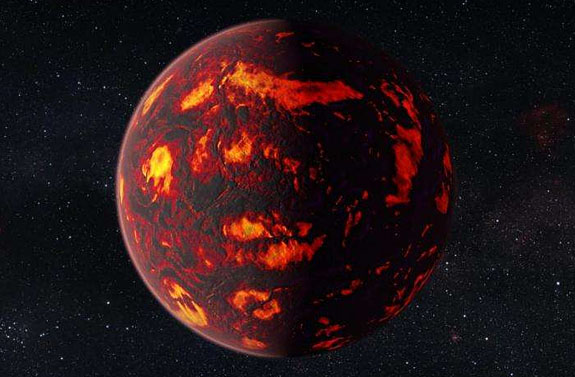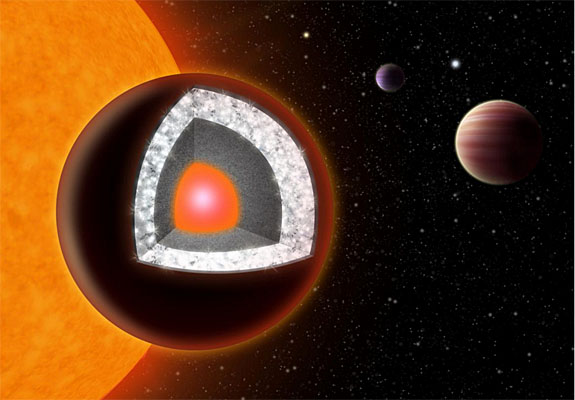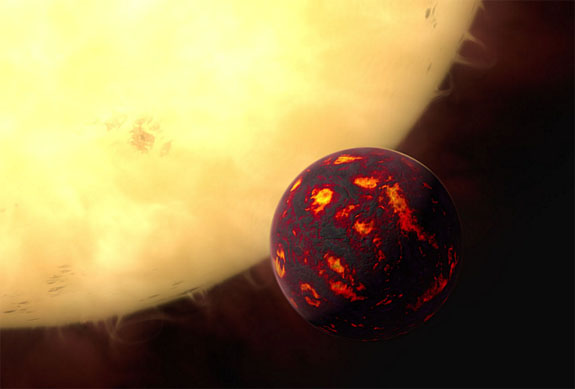March 2nd, 2016
Using the Wide Field Camera on board the Hubble Space Telescope, a group of UK researches were able to add evidence to the theory that super-Earth 55 Cancri e — which revolves around a star 40 light years away — is, indeed, a "diamond planet."

Back in 2012, Yale astrophysicists estimated that the carbon-based super-planet was about two times the size of Earth, eight times more dense and had a surface temperature of 3,900 degrees Fahrenheit.

The presence of carbon, combined with high density and extreme heat create the perfect conditions for creating diamonds. They speculated that one-third of the planet could be composed of pure diamond.
Taking a stab at the potential value of a diamond planet, a Forbes columnist did the math and came up with a value of $26.9 nonillion. That's $26.9 followed by 30 zeros. Sadly, the prospects of claiming that fortune are unlikely because of the intense heat, poisonous atmosphere and inconvenient distance of 230 trillion miles.
Located in the northern constellation of Cancer, the diamond planet's host star is clearly visible with the naked eye.

The Hubble Space Telescope, which was launched into low Earth orbit back in 1990, continues to unveil chemical curiosities throughout the universe. In the case of 55 Cancri e, the Wide Field Camera was able to detect the presence of hydrogen cyanide among the hydrogen and helium gases swirling around the planet. Hydrogen cyanide is an indicator that carbon compounds may also make up part of its atmosphere.
The findings were announced by an international team, led by scientists from University College London (UCL) in the UK. A complete report will be published in the Astrophysical Journal.
“This is a very exciting result because it’s the first time that we have been able to find the spectral fingerprints that show the gases present in the atmosphere of a super-Earth,” explained Angelos Tsiaras, a PhD student at UCL, who developed the analysis technique along with his colleagues Ingo Waldmann and Marco Rocchetto.
55 Cancri e is considered an unusual super-Earth because it orbits very close to its parent star. A year on 55 Cancri e lasts for only 18 hours.
“If the presence of hydrogen cyanide and other molecules is confirmed in a few years time by the next generation of infrared telescopes, it would support the theory that this planet is indeed carbon rich and a very exotic place,” UCL's Jonathan Tennyson told spacetelescope.org. “Although hydrogen cyanide, or prussic acid, is highly poisonous, so it is perhaps not a planet I would like to live on!”
Images courtesy of ESA/Hubble, M. Kornmesser; Haven Giguere, Yale.

Back in 2012, Yale astrophysicists estimated that the carbon-based super-planet was about two times the size of Earth, eight times more dense and had a surface temperature of 3,900 degrees Fahrenheit.

The presence of carbon, combined with high density and extreme heat create the perfect conditions for creating diamonds. They speculated that one-third of the planet could be composed of pure diamond.
Taking a stab at the potential value of a diamond planet, a Forbes columnist did the math and came up with a value of $26.9 nonillion. That's $26.9 followed by 30 zeros. Sadly, the prospects of claiming that fortune are unlikely because of the intense heat, poisonous atmosphere and inconvenient distance of 230 trillion miles.
Located in the northern constellation of Cancer, the diamond planet's host star is clearly visible with the naked eye.

The Hubble Space Telescope, which was launched into low Earth orbit back in 1990, continues to unveil chemical curiosities throughout the universe. In the case of 55 Cancri e, the Wide Field Camera was able to detect the presence of hydrogen cyanide among the hydrogen and helium gases swirling around the planet. Hydrogen cyanide is an indicator that carbon compounds may also make up part of its atmosphere.
The findings were announced by an international team, led by scientists from University College London (UCL) in the UK. A complete report will be published in the Astrophysical Journal.
“This is a very exciting result because it’s the first time that we have been able to find the spectral fingerprints that show the gases present in the atmosphere of a super-Earth,” explained Angelos Tsiaras, a PhD student at UCL, who developed the analysis technique along with his colleagues Ingo Waldmann and Marco Rocchetto.
55 Cancri e is considered an unusual super-Earth because it orbits very close to its parent star. A year on 55 Cancri e lasts for only 18 hours.
“If the presence of hydrogen cyanide and other molecules is confirmed in a few years time by the next generation of infrared telescopes, it would support the theory that this planet is indeed carbon rich and a very exotic place,” UCL's Jonathan Tennyson told spacetelescope.org. “Although hydrogen cyanide, or prussic acid, is highly poisonous, so it is perhaps not a planet I would like to live on!”
Images courtesy of ESA/Hubble, M. Kornmesser; Haven Giguere, Yale.

